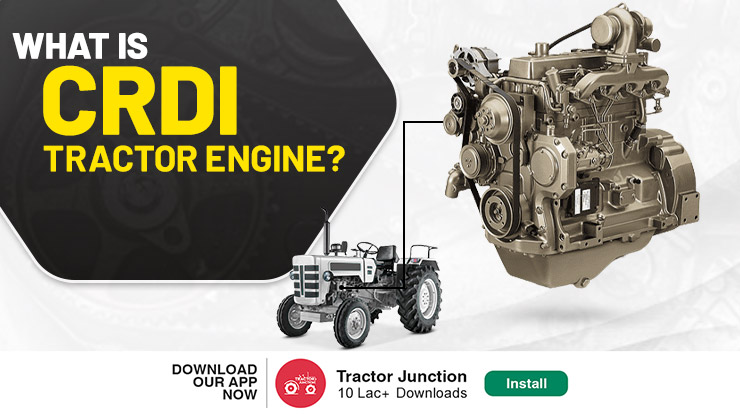
As long as food production and crop productivity are the need of the hour, farm mechanisation and innovations will keep fulfilling global hunger. In this regard, CRDI tractor engines have been one of the newest innovations (that has been applied) in the agritech industry. Additionally speaking, innovated the last year, CRDI expands for Common Rail Direct Injection.
Furthermore, this tractor engine technology persists in the use of an electric motor-powered common rail. This motor-powered rail is individually connected to all the fuel injectors. Furthermore, it checks the fuel supply in the engine cylinders. In addition to the above facts, the fuel supply to the engine cylinders is controlled by the algorithmic and programmed motor. Furthermore, this motor overrides the traditional fuel injection mechanism to supply fuel as per the electronic signals received from the electronic circuit of the motor.
In this blog, we will discuss the CRDI tractor engines and their working in detail. Furthermore, we will discuss the increment in crop productivity due to technology. Furthermore, we will also discuss the sustainability of technology with nature.
What are CRDI Tractor Engines?
In reference to the pledge to carbon neutrality by governments across the globe, the CRDI tractor engines have been brought back after their invention in the 1960s. The technology was innovated by Swiss scientists Rober Huber and Dr Marco Ganser. However, the first utilisation of diesel engine technology was successfully carried out in the mid-1990s.
In addition to the above facts, as the tech in electronics has improved significantly, the ECUs (Electronic Control Units) have. These ECUs are known to control the direct injection system in diesel engines. Henceforth, in this way, the ECUs check the overflow of fuel in the engine cylinders as per the load requirements. Hence, to prevent extra-fuel burning and related carbon emissions, this technology is considered one of the most effective technologies.
Working of CRDI Tractor Engines
A solenoid or piezoelectric valve used as an electronic commander for fuel injection. The time and amount of fuel injection decided by the power requirements at the time of operation. While the traditional direct injection configuration helps in pressurising and atomising the fuel. With regards to the above explanation, segments of CRDI tractor engines mentioned below.

- The electronic fuel siphon: It consists of an electric motor, roller-cell pump, non-return valve, a rail-pressure sensor (RDS) and an injector.
- Pressuring factor control valve (DRV): It holds the pressure steady.
- High Pressing Factor Siphon
- ECU with Sensors Common Rail: This controls the infusion network.
The working of sensor-based CRDI tractor engines is the same as traditional direct injection tractor engines except for the fuel transmission part and its direct control by ECUs. The pressure to atomise the fuel is around 15000 PSI. Additionally speaking, this pressure at the injection point in the engine cylinders almost turns the liquid gas into gas.
Furthermore, this atomised liquid, when put into engine cylinders of a compression ignition engine, ignites up to start the engine and henceforth power the tractor. The most modern of technology units have a single injector framework per unit with a turbocharger.
The benefits of CRDI technology in tractor engines

The benefits of CRDI tractor engines include the following viewpoints:
- The tractors with this technology expected to have 25% more torque than traditional technology.
- This technology enables the tractor to reduce vibrations and clamour.
- The technology responsible for higher mileage and improved power performance as compared to traditional DI/turbocharged engines.
- This technology helps to reduce carbon emissions and is can reduce pressure on governments with regard to the carbon neutrality pledge.
The future and sustainability of agriculture with CRDI tractor engines
As we have discussed in the earlier sessions, the carbon footprint will significantly decrease with reduced usage of fossil fuels by using CRDI tractor engines. Furthermore, we also acknowledged that these types of technologies utmostly needed in India as its economy is majorly dependent on agriculture.
Talking a bit further, the direct injection diesel engine technology will revolutionalise the farming sector. Furthermore, it will bring more and more consciousness among farmers and manufacturers regarding the importance of carbon neutrality in agriculture. Henceforth, further making sure competitiveness in the segment. We, as conscious members of the planet and experts, say these CRDI diesel engines are the nearest sustainable future in agritech in India.
How will CRDI engines affect productivity in agriculture?
As we discussed in the benefits section, CRDI engines have improved torque, fuel efficiency, and power performance. In this manner, these are offering a better source to save fuel and increase output power at the same time. Speaking about these two parameters, they are the farmer’s two best friends. Henceforth, productivity will automatically increase as compared to using traditional tractor engines as a source of power. Imagine you have more power output at lesser input costs. In such scenarios, the CRDI engine will effectively and efficiently boost agricultural productivity.
The unwrapped truth
This blog has discussed the working of CRDI tractor engines. In this blog, we have discussed the working of the common rail direct injection technology. In addition, we have discussed the possible increment in crop productivity due to the technology. It is no hidden fact that under strict government norms, tractor manufacturers will forced to adopt technologies like CRDI engines.
Related Blog
How does Tractor Engine work
How to Check the Health of a Used Tractor Engine
